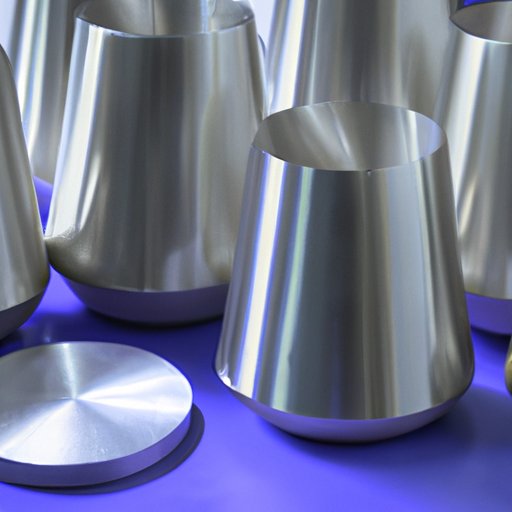Introduction
Aluminum oxynitride (AlON) is a high-performance ceramic material with excellent optical, thermal and mechanical properties. It has a wide range of applications in the aerospace, automotive and medical industries due to its superior strength and durability. This article will explore the properties and applications of aluminum oxynitride, as well as the manufacturing processes involved in producing the material.
What is Aluminum Oxynitride?
Aluminum oxynitride is an aluminum nitride-based ceramic material that has been developed in recent years. It is composed of aluminum, oxygen and nitrogen atoms, and has a cubic crystal structure. The material has a unique combination of properties, such as high optical transparency, good thermal conductivity, high hardness and wear resistance, and excellent electrical insulation. These properties make aluminum oxynitride an ideal material for use in a variety of applications, such as aerospace components, automotive parts, and medical devices.

Properties and Applications of Aluminum Oxynitride
Aluminum oxynitride has a number of advantageous properties which make it suitable for a wide range of applications. Its high optical transparency makes it ideal for use in lenses, windows and optical filters. Its thermal conductivity is also very good, making it useful for heat sinks, heat exchangers and other thermal management applications. Additionally, its hardness and wear resistance make it ideal for use in cutting tools, abrasives and bearings. Its electrical insulation makes it suitable for use in electrical components and circuits. Finally, its corrosion resistance makes it suitable for use in medical implants and dental tools.

Manufacturing Processes for Aluminum Oxynitride
The manufacturing process for aluminum oxynitride involves several steps. First, the raw materials are mixed together in a powder form. This mixture is then compressed into a mold to form a compacted green body, which is then sintered at high temperatures. During this process, the nitrogen and oxygen atoms react with the aluminum atoms to form a strong, dense material. After sintering, the material is then machined to the desired shape and size.
Producing aluminum oxynitride can be challenging, as the material is difficult to work with and requires special equipment. Additionally, the sintering process must be carefully controlled in order to achieve the desired properties. As a result, aluminum oxynitride is typically produced in small batches, which can make it more expensive than other materials.

How Aluminum Oxynitride is Used in the Aerospace Industry
Aluminum oxynitride is increasingly being used in the aerospace industry for a variety of applications. The material’s superior strength and light weight make it ideal for use in aircraft components, such as airframes, landing gear, and engine components. Additionally, its optical transparency and thermal conductivity make it suitable for use in windows, shields and heat exchangers. Designers must also consider the material’s wear resistance, electrical insulation and corrosion resistance when selecting aluminum oxynitride for an application.
The Benefits of Aluminum Oxynitride in Aerospace Applications
Aluminum oxynitride offers a number of advantages for aerospace applications. Its lightweight design reduces the overall weight of the aircraft, which leads to improved fuel efficiency. Additionally, its superior strength and wear resistance make it ideal for use in high-stress components, such as landing gear and engine components. The material’s electrical insulation also makes it suitable for use in electrical components, such as wiring and connectors.
Aluminum Oxynitride as a High-Performance Ceramic Material
Aluminum oxynitride is a high-performance ceramic material with excellent properties. Its high hardness and wear resistance make it ideal for use in cutting tools and abrasives. Additionally, its thermal conductivity and optical transparency make it suitable for use in heat sinks and optical filters. Finally, its electrical insulation makes it suitable for use in electrical components and circuits.

Aluminum Oxynitride in Automotive Manufacturing
Aluminum oxynitride is becoming increasingly popular in the automotive industry, due to its superior properties. Its lightweight design makes it ideal for use in vehicle components, such as engine blocks, exhaust systems and body panels. Additionally, its corrosion resistance and durability make it suitable for use in components exposed to harsh environments, such as brakes and transmissions. Finally, its electrical insulation makes it suitable for use in electrical components, such as sensors and connectors.
Analyzing the Impact of Aluminum Oxynitride on Lightweight Design
Aluminum oxynitride is a key component in lightweight design. By reducing the overall weight of a vehicle or aircraft, aluminum oxynitride can lead to cost savings from reduced fuel consumption. Additionally, lighter vehicles and aircraft have improved performance and improved safety. Finally, the use of aluminum oxynitride can lead to increased production efficiency, as less material is needed to produce the same product.
Exploring the Potential of Aluminum Oxynitride in Medical Devices
Aluminum oxynitride has a number of advantages for use in medical devices. Its high hardness and wear resistance make it ideal for use in orthopedic implants, such as hip replacements and bone screws. Additionally, its corrosion resistance and electrical insulation make it suitable for use in dental tools, such as drills and files. Finally, its thermal conductivity makes it suitable for use in medical instruments, such as thermometers and imaging equipment.
Conclusion
Aluminum oxynitride is a high-performance ceramic material with a wide range of applications in the aerospace, automotive and medical industries. Its superior properties, such as its high hardness, wear resistance and electrical insulation make it ideal for use in a variety of applications. Additionally, its lightweight design makes it suitable for use in lightweight design, leading to cost savings and improved performance. As the demand for aluminum oxynitride continues to grow, it is likely that new applications will be developed in the near future.
The potential of aluminum oxynitride is vast, and its use is expected to continue to expand in the coming years. As more companies explore the benefits of this material, it is likely that new applications will be developed. With its superior properties and wide range of applications, aluminum oxynitride is sure to remain an important material in the aerospace, automotive and medical industries for many years to come.

